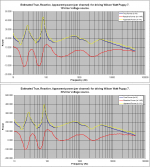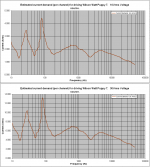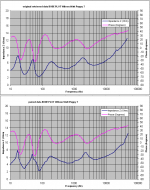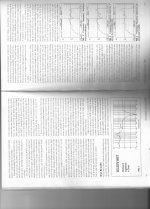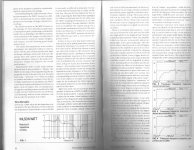Just for fun
This is an estimation based on the impedance of Watt / Puppy 7 as published by Stereophile
Wilson Audio Specialties WATT/Puppy 7 loudspeaker Measurements | Stereophile.com
I digitized the data using Digitize graphical data with Dagra
Then I spent some hours doing data pairing and then had Excel perform the calculations
According to published sensitivity of 93dB/W/m, 10V rms drive (~25W) would correspond to approx ~96dB spl (midrange I guess) at 5 m with two loudspeakers playing.
For 10 dB spl more (doubling the sense of volume), the drive would need to be approx 30Vrms (~225W)
George
This is an estimation based on the impedance of Watt / Puppy 7 as published by Stereophile
Wilson Audio Specialties WATT/Puppy 7 loudspeaker Measurements | Stereophile.com
I digitized the data using Digitize graphical data with Dagra
Then I spent some hours doing data pairing and then had Excel perform the calculations
According to published sensitivity of 93dB/W/m, 10V rms drive (~25W) would correspond to approx ~96dB spl (midrange I guess) at 5 m with two loudspeakers playing.
For 10 dB spl more (doubling the sense of volume), the drive would need to be approx 30Vrms (~225W)
George
Attachments
Last edited:
Both on and off topic, but a fine piece from JGH in 1968 Why Argue? | Stereophile.com
I'll let people decide why I think it is amusing given later JGH writings...
And I do wonder if JC is the Ampex Engineer referenced in the article. Seems about the right timeframe...
I'll let people decide why I think it is amusing given later JGH writings...
And I do wonder if JC is the Ampex Engineer referenced in the article. Seems about the right timeframe...
You are welcome Dejan.
I’ve searched for related work but I have not found much.
The issue has been investigated in the 80ies. I’ve found two papers
http://www.genelec.com/sites/default/files/media/About%20Us/Academic_Papers/11775.pdf
http://www.genelec.com/sites/default/files/media/About%20Us/Academic_Papers/11870.pdf
There are two more papers to which I have no access:
P.J. Baxandall, "A Technique for Displaying the Current and Voltage Output Capability of Amplifiers and Relating this to the Demands of Loudspeakers," presented at the 82nd Convention of the Audio Engineering Society (1987 March). Preprint 2421. J. Aud. Eng. Soc. Vol.36, p.3 (1988 January/February).
E. Benjamin, "Audio Amplifiers for Loudspeaker Loads," presented at the 93rd Convention of the Audio Engineering Society (1992 October). Preprint 3432. J. Aud. Eng. Soc. Vol.42, pp.670-683 (1994 September).
George
I’ve searched for related work but I have not found much.
The issue has been investigated in the 80ies. I’ve found two papers
http://www.genelec.com/sites/default/files/media/About%20Us/Academic_Papers/11775.pdf
http://www.genelec.com/sites/default/files/media/About%20Us/Academic_Papers/11870.pdf
There are two more papers to which I have no access:
P.J. Baxandall, "A Technique for Displaying the Current and Voltage Output Capability of Amplifiers and Relating this to the Demands of Loudspeakers," presented at the 82nd Convention of the Audio Engineering Society (1987 March). Preprint 2421. J. Aud. Eng. Soc. Vol.36, p.3 (1988 January/February).
E. Benjamin, "Audio Amplifiers for Loudspeaker Loads," presented at the 93rd Convention of the Audio Engineering Society (1992 October). Preprint 3432. J. Aud. Eng. Soc. Vol.42, pp.670-683 (1994 September).
George
P.J. Baxandall paper has been uploaded by Jan Didden here:
http://linearaudio.nl/sites/linearaudio.net/files/bax%20i-v%20prot.pdf
Thank you Jan
George
http://linearaudio.nl/sites/linearaudio.net/files/bax%20i-v%20prot.pdf
Thank you Jan
George
E. Benjamin, "Audio Amplifiers for Loudspeaker Loads," presented at the 93rd Convention of the Audio Engineering Society (1992 October). Preprint 3432. J. Aud. Eng. Soc. Vol.42, pp.670-683 (1994 September).
George
You can contact Eric on the Yahoo micbuilders list, I'm sure he would send you a copy. We corresponded frequently when I did my 2 part article for LA.
Wilson WATT Series 3-Puppy 2 loudspeaker Measurements | Stereophile.com
The earlier ones were a lot harder to drive. not yet found a impedance curve for the original Watt which was sub 1-Ohm in places.
The earlier ones were a lot harder to drive. not yet found a impedance curve for the original Watt which was sub 1-Ohm in places.
Only when reading in bed 😀
So that's quite a fearsome looking load to drive. Maybe a candidate for a 'sensed' feedback connection at the speaker terminals to take the cable/connection interface out of the equation. You never see that done these days.
So that's quite a fearsome looking load to drive. Maybe a candidate for a 'sensed' feedback connection at the speaker terminals to take the cable/connection interface out of the equation. You never see that done these days.
but I have not found much.
A very good article
Heavy Load: How Loudspeakers Torture Amplifiers | Stereophile.com
Also D. self has devoted a chapter (Chapter 40 “Cool Audio Power”) in the third edition of his
Self on AudioThe Collected Audio Design Articles of Douglas Self 3rd edition,
https://www.routledge.com/products/9781138854468
You can contact Eric on the Yahoo micbuilders list,
Thank you Scott. Unfortunately his e-mail address is not visible to me.
The earlier ones were a lot harder to drive.
Bill, thanks for the info but I will not devote more time on these speakers.🙂
WATT1. My amps will drive it
Good for you Mr. Curl
George
audio purist
EDIT: His speakers were not difficult loads, and were selected for their suitability as end tables as far as I could tell.
The last I recall was a Kenwood "Audio Purist" product. My father acquired one, I think to tease my audiophile brother. I don't remember if he actually used the sense leads or not, or just strapped things at the amp.So that's quite a fearsome looking load to drive. Maybe a candidate for a 'sensed' feedback connection at the speaker terminals to take the cable/connection interface out of the equation. You never see that done these days.
EDIT: His speakers were not difficult loads, and were selected for their suitability as end tables as far as I could tell.
Last edited:
Keith Howard is a voice of reason and sanity, and this is well-demonstrated here.
The last I recall was a Kenwood "Audio Purist" product. My father acquired one, I think to tease my audiophile brother. I don't remember if he actually used the sense leads or not, or just strapped things at the amp.
I'm struggling to remember the one I was thinking of. Japanese, yes... can't recall which it was now.
EDIT: His speakers were not difficult loads, and were selected for their suitability as end tables as far as I could tell.
🙂 that's a nice story. Things were very different back then.
See for example https://books.google.com/books?id=q...JjAB#v=onepage&q=kenwood audio purist&f=falseI'm struggling to remember the one I was thinking of. Japanese, yes... can't recall which it was now.
Sure, very old and quite standard. It's a little more tricky to apply to wide-bandwidth power amps. Actually, considering that cable manufacturers are always looking for new opportunities, including questionable claims for improved data transmission cables, I'm surprised that someone hasn't jumped on yet another bandwagon.I see remote sensing all the time....... in power supplies.
Cheers
Alan
- Status
- Not open for further replies.
- Home
- Member Areas
- The Lounge
- John Curl's Blowtorch preamplifier part II
